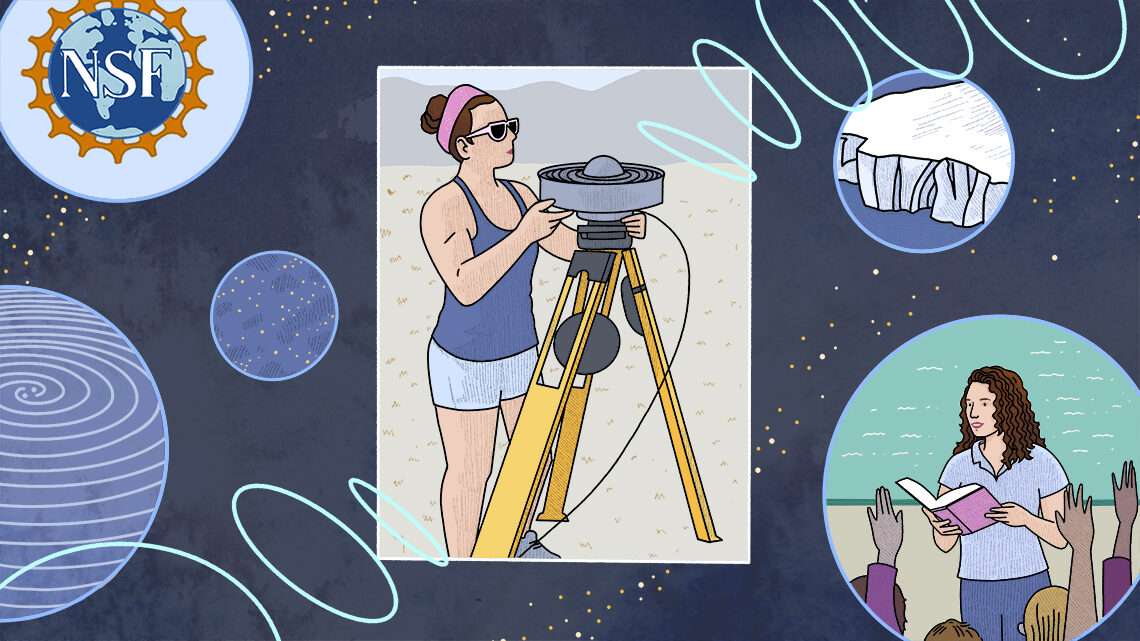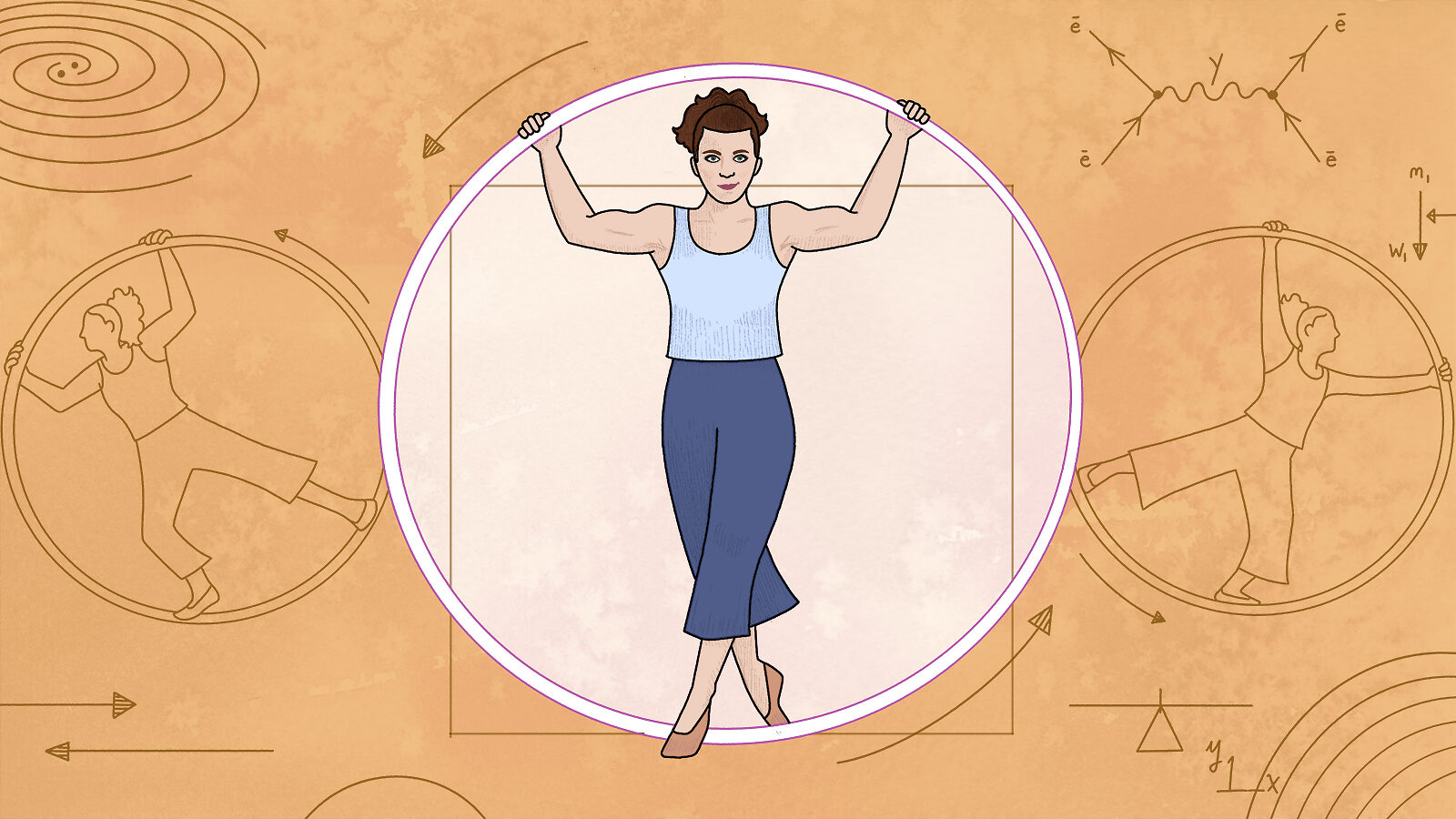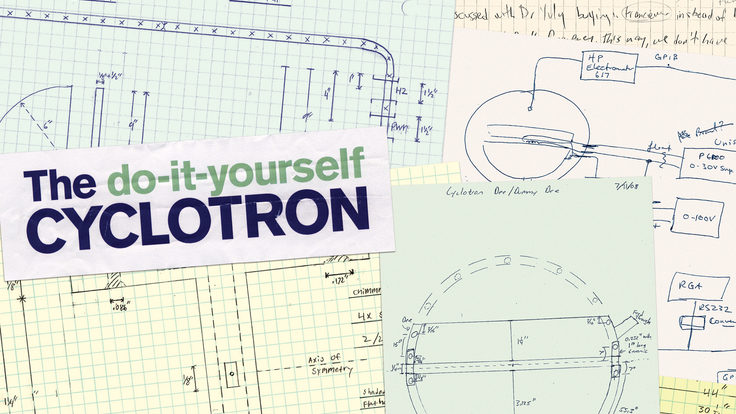In a recent presentation, circus performer Julia Ruth played a reel of clips from her acts, which featured her spinning on a rope hanging from the ceiling, walking and jumping on stilts, and rolling around on a Cyr wheel.
For the uninitiated, the Cyr (pronounced like “sear”) wheel is a large metal ring, often made of aluminum, steel or titanium. A performer stands inside the wheel with feet and hands on the rim, looking like Leonardo da Vinci’s Vitruvian Man. The performer rolls and spins on the edge of the wheel, causing it to move gyroscopically. The performer then releases and moves their limbs one or two at a time to manipulate the ring’s trajectory and perform acrobatics inside.
Ruth says the Cyr wheel is one of her favorites because it clearly demonstrates so many important physical principals, including center of mass, conservation of momentum, balance, acceleration and leverage.
Ruth knows these principles inside and out, in part because of her acrobat training, and in part because—though her PhD studies are on hold for the moment—she is both a science educator and a physicist. Ruth presented about her work at a unique session of the April 2022 meeting of the American Physical Society.

Kicking off
Ruth and her family grew up close to the University of Maryland, where her father was a professor. A German immigrant to the US, he took his family back to his country of birth for a sabbatical year, and that’s where Ruth was first introduced to physics—in ninth grade at a German-speaking high school. Growing up, she didn’t speak German with her father at home, so school was her first exposure to the language. But the class caught her attention anyway.
“Despite the language barrier, I just was so captivated by it,” Ruth says.
Upon returning to the States, Ruth immersed herself in physics. She attended a science and technology magnet high school and, during her senior year, conducted dark-matter research with a University of Maryland professor. The following summer, Ruth worked with another UMD professor on gravitational-wave research.
It wasn’t until she attended UMD as an undergraduate that Ruth discovered her passion for performance. It started as a casual interest in the school’s gymnastics and acrobatics student group; Ruth had no experience but thought it could be fun to try.
She admits that she was “awful” at first, but she says that changed when a coach began to explain things to her in terms of physics. “That’s when things started to click and I finally started to get a little bit better,” she said in her APS talk.
At first, Ruth had no interest in performing. “I was just so terrified of being in front of people,” she says.
But, she says, one day she was finally “suckered” into it—and it changed the trajectory of her life. “The second I got off that first performance I did, I was like, ‘This is amazing. I feel so good right now!’”
Finding her balance
At the time, Ruth was working as a research scientist. She had an internship at NASA, where she studied the layers of the Antarctic ice sheet.
After that, she researched North Pole sea ice with the National Oceanic and Atmospheric Administration. That’s when she met Sinéad Farrell, her eventual research adviser, friend and mentor.
Farrell, an associate professor of Geographical Sciences and Atmospheric & Oceanic Science at UMD, says she was immediately impressed by Ruth’s CV, including the unusual mention of acrobatics experience. She was even more impressed when she first saw Ruth perform. “I still have goose bumps to this day because there’s my student and she’s doing acrobatics!” she says. “[The performers were] jumping through hoops of fire, and she was hanging out of the [aerial] silk. I nearly died of surprise.”
When Ruth’s undergrad years ended, she wasn’t ready to give up her first love, science. So she started her PhD in geophysics at the Scripps Institution of Oceanography in San Diego with a prestigious National Science Foundation Graduate Research Fellowship.
In grad school she balanced classes, research and studying with training, coaching circus students and performing. Through it all, she prioritized getting eight hours of sleep every night, even if that meant sometimes missing a homework assignment.
As she continued to feel drawn to performance, Ruth knew she had a decision to make. After earning her master’s degree, Ruth decided it was now or never: Physics classes are a bit more forgiving, but the human body can only do acrobatics for so long.
Ruth ran away to join the circus.
“Taking that leap, leaving grad school in a PhD program with a National Science Foundation scholarship was a terrifying thing for me to do,” she said in the APS session.
At first, Ruth taught middle school science classes to support herself while she freelanced as a circus performer. After a few years, she was able to make circus performance her full-time job, with a smaller amount of teaching on the side.
Maintaining momentum
The circus performer’s life isn’t for everyone, but Ruth says she loves it. In the past two years alone, Ruth has performed in seven states and has lived in seven different homes in two countries. There is no 9-to-5 schedule, and she often works weekends and holidays. Even as a full-time performer, Ruth still teaches, virtually, subjects ranging from English as a second language to exercise and flexibility to astronomy and modern physics.
When she isn’t performing or teaching, Ruth trains relentlessly: weightlifting, stretching, practicing her specialties, and doing rehab and “prehab.” (This 29-year-old plans on performing for the next 10 to 15 years, so keeping up her strength and flexibility is of the upmost importance.)
Physics research was much less physically demanding, but Ruth has found many similarities between her two fields. Both require communicating with an audience. This is especially true for teaching science, which is the aspect of physics Ruth says she is most passionate about. “Preparing to teach a lesson feels a lot like preparing for a performance,” she says.
In addition, both circus performing and science involve research and study, and both are skills taught at institutions of higher learning. (Stockholm University of the Arts even has a Department of Circus where students can earn a PhD in circus research.)
As for her own education, Ruth still wholeheartedly intends to finish her physics PhD some day. Farrell, who has stayed in touch with her former student and was able to see Ruth perform again prior to the pandemic, says she believes she can do it. “Whatever she does, she’s super successful,” she says. “She should be in the spotlight, that’s for sure.”
Ruth closed her APS talk with the advice she says she gives to everyone, whether circus performer or scientist: “I really want to encourage you to follow your passions. Every time you take this leap—I encourage you to do it every day, even small leaps—every time you do, you grow as a person. You reach new boundaries, and you really challenge yourself to be a stronger human being.”







